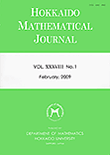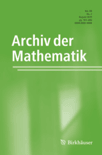
Collectanea Mathematica
Scope & Guideline
Exploring the depths of theoretical and applied mathematics.
Introduction
Aims and Scopes
- Algebra and Combinatorics:
The journal frequently publishes papers on algebraic structures, including Gorenstein modules, edge ideals, and combinatorial aspects of algebra. This area showcases the interplay between algebraic concepts and combinatorial techniques. - Geometry and Topology:
Research focusing on geometric structures, such as manifolds and algebraic varieties, is prevalent. Topics range from the study of moduli spaces to the properties of specific geometric constructions like tropical curves and Fano manifolds. - Functional Analysis and Operator Theory:
The journal includes contributions on functional spaces, operator theory, and related inequalities. This encompasses studies on maximal operators, composition operators, and various function spaces, indicating a strong emphasis on analysis. - Homological Algebra and Algebraic Geometry:
A significant focus on homological aspects, particularly in connection with ideals and modules, and their applications in algebraic geometry. This includes investigations into syzygies, depth, and regularity of various algebraic structures. - Partial Differential Equations and Variational Problems:
The journal addresses various aspects of PDEs, particularly those arising in geometric contexts or with variational principles. This includes papers discussing existence results, boundary value problems, and critical Sobolev inequalities.
Trending and Emerging
- Intersection of Algebra and Geometry:
There is a growing trend in exploring the connections between algebraic structures and geometric properties, particularly in the study of moduli spaces and toric varieties, indicating a rich interplay between these fields. - Nonlinear Analysis and PDEs:
An increasing number of publications are focusing on nonlinear problems, particularly those involving partial differential equations and variational methods, reflecting a heightened interest in complex analysis and its applications. - Mathematical Physics Applications:
Emerging themes related to mathematical physics, such as the study of spacelike hypersurfaces and Ricci curvature, show a trend towards applying mathematical theories to physical contexts, suggesting interdisciplinary research growth. - Computational Methods in Algebra:
There is an uptick in papers that employ computational techniques to solve algebraic problems or analyze algebraic structures, indicating a trend towards integrating computational tools in traditional mathematical research.
Declining or Waning
- Classical Analysis Techniques:
There is a noticeable reduction in papers focusing solely on classical analytical techniques, with fewer contributions on traditional topics such as basic functional analysis or introductory harmonic analysis. - Elementary Number Theory:
The journal has seen fewer articles dedicated to elementary number theory compared to previous years. This could indicate a shift towards more advanced or applied aspects of mathematics. - Discrete Mathematics:
Although discrete mathematics remains important, there is a decline in publications focused strictly on combinatorial problems or graph theory without significant algebraic or geometric connections.
Similar Journals

European Journal of Mathematics
Your Gateway to High-Quality Mathematical ResearchWelcome to the European Journal of Mathematics, a prominent publication that serves as a vital platform for disseminating high-quality research in the field of mathematics. Published by Springer International Publishing AG, this journal has witnessed significant growth since its inception in 2015 and is recognized for its contributions within the Q2 category of Mathematics (miscellaneous) as per the 2023 rankings. With an ISSN of 2199-675X and an E-ISSN of 2199-6768, the journal aims to foster innovation and collaboration among researchers, professionals, and students alike. Although it operates under a traditional access model, the journal's commitment to advancing mathematical knowledge and applications cannot be overstated. Positioned among the top-tier publications, the European Journal of Mathematics is an essential resource that encourages the exploration of emerging trends and theories in mathematics, making it indispensable for anyone striving to stay at the forefront of this dynamic field.

Revista Matematica Complutense
Advancing Mathematical Frontiers with Rigorous ResearchRevista Matematica Complutense is a prestigious peer-reviewed journal published by SPRINGER-VERLAG ITALIA SRL, specializing in the field of mathematics. With its ISSN 1139-1138 and E-ISSN 1988-2807, the journal plays a vital role in disseminating high-quality research and fostering academic discussion within the mathematics community. Recognized for its rigorous selection process, the journal has achieved impressive rankings, holding a Q1 quartile status in the miscellaneous mathematics category as of 2023 and ranking #94 out of 399 in general mathematics according to Scopus, placing it within the 76th percentile. With a publication timeline spanning from 2008 to 2024, the Revista Matematica Complutense continues to serve as an essential resource for researchers, professionals, and students alike. Although it does not currently offer open access, the journal remains committed to advancing mathematical knowledge and providing a platform for innovative research across various mathematical disciplines.

Periodica Mathematica Hungarica
Advancing Mathematical Frontiers, One Study at a Time.Periodica Mathematica Hungarica is a prestigious academic journal published by Springer, focusing on the field of mathematics, with a particular emphasis on miscellaneous mathematical studies. Established in 1971, this journal has maintained its commitment to advancing mathematical research and its applications, making significant contributions over its converged years through 2024. With a Q2 ranking in the mathematics category as of 2023, it establishes itself as a vital resource within the mathematical community. Researchers and academics will find its inclusion in the Scopus database, ranking #189 out of 399 in general mathematics, indicative of its impact and relevance. Although it does not feature open access, the journal provides a wealth of high-quality peer-reviewed articles, thereby serving as an essential platform for the dissemination of innovative mathematical theories, methodologies, and findings. Engaging with the content of Periodica Mathematica Hungarica is crucial for anyone looking to stay at the forefront of mathematical research and development.

PUBLICATIONES MATHEMATICAE DEBRECEN
Charting the Course of Mathematical ExcellencePublicationes Mathematicae Debrecen is a renowned international journal published by the University of Debrecen, Institute of Mathematics, situated in Hungary. This journal, with both ISSN 0033-3883 and E-ISSN 2064-2849, has established itself in the field of mathematics since its inception, with coverage extending from 1997 to 2024. Recognized for its rigorous academic standards, it currently holds a Q3 ranking in the mathematics (miscellaneous) category for 2023 and ranks at the 42nd percentile among general mathematics journals in Scopus. Publicationes Mathematicae Debrecen aims to disseminate high-quality research across various areas of mathematics, contributing to the advancement of knowledge and practice in this dynamic field. Although it is not an open-access journal, its readers can access a wealth of scholarly work that addresses both theoretical and applied mathematical issues, making it an invaluable resource for researchers, professionals, and students alike.

Hokkaido Mathematical Journal
Elevating mathematical discourse with every publication.Hokkaido Mathematical Journal, published by Hokkaido University, Department of Mathematics, stands as a pivotal platform for scholarly discourse in the field of mathematics. Established in 1972, this peer-reviewed journal has consistently contributed to the advancement of mathematical research, covering a wide spectrum of topics within the discipline. With its current ranking in the third quartile (Q3) among miscellaneous mathematics journals, it offers valuable insights and findings that cater to both established researchers and budding mathematicians alike. The journal is accessible through traditional subscription, fostering a community that values rigorous theoretical exploration and applied mathematical methods. As it approaches its convergence year in 2024, Hokkaido Mathematical Journal remains essential for those dedicated to pushing the boundaries of mathematical knowledge and innovation in Japan and beyond.

Rendiconti del Circolo Matematico di Palermo
Advancing Knowledge in the Heart of Mathematics.Rendiconti del Circolo Matematico di Palermo, published by SPRINGER-VERLAG ITALIA SRL, is a revered journal in the field of mathematics, emphasizing the cultivation and dissemination of mathematical knowledge since its inception in 1887. With its ISSN 0009-725X and E-ISSN 1973-4409, this esteemed publication has continued to thrive, showcasing innovative research, comprehensive reviews, and thoughtful discussions from diverse areas in mathematics, particularly in its Q2 ranking within the miscellaneous mathematics category. Its historical significance is underscored by its convergence of publications across numerous years, including its notable periods from 1887 to 1916, 1919 to 1938, and beyond, effectively capturing the evolution of mathematical thought. Though not open access, the journal remains an essential resource for researchers, professionals, and students aiming to stay updated with the latest advancements and methodologies in the ever-evolving landscape of mathematics. With its Scopus rank placing it in the top 25th percentile, Rendiconti del Circolo Matematico di Palermo continues to be a cornerstone for scholarly dialogue and development in its domain.

Eurasian Mathematical Journal
Connecting Theory with Practical Innovation.Welcome to the Eurasian Mathematical Journal, a prominent platform dedicated to advancing the field of mathematics, particularly in its miscellaneous applications. Published by the esteemed L N Gumilyov Eurasian National University in Kazakhstan, this journal has been serving the academic community since 2014. With an ISSN of 2077-9879, it has successfully carved its niche within the mathematical landscape, presently ranked Q2 and placing in the 64th percentile among general mathematics publications in Scopus. The journal aims to foster scholarly exchange through high-quality research articles, reviews, and theoretical advancements that enhance understanding and application of mathematical concepts. By prioritizing open accessibility and a rigorous peer-review process, the Eurasian Mathematical Journal contributes significantly to both theoretical exploration and practical innovation, making it an essential resource for researchers, professionals, and students alike.

St Petersburg Mathematical Journal
Elevating Algebra and Analysis through Research ExcellenceSt Petersburg Mathematical Journal, published by the American Mathematical Society, is a distinguished platform that fosters research and discourse in the fields of mathematics, specifically focusing on Algebra and Number Theory, Analysis, and Applied Mathematics. With an ISSN of 1061-0022 and an E-ISSN of 1547-7371, this journal has been a reliable source of cutting-edge mathematical research since its inception in 2003 and continues to publish high-quality content through 2024. Although not open-access, it offers valuable insights and advances the mathematical community's understanding, as indicated by its respectable impact factor and Scopus rankings across various categories—landing in the Q3 quartile across three significant mathematical disciplines. Researchers, professionals, and students are encouraged to contribute and engage with this journal, as it remains a vital resource for promoting collaboration and discovery within the ever-evolving field of mathematics.

Milan Journal of Mathematics
Enriching mathematical discourse for future generations.Milan Journal of Mathematics is a prestigious academic publication dedicated to advancing the field of mathematics, particularly in the miscellaneous areas of the discipline. Published by SPRINGER BASEL AG in Switzerland, this journal has established a strong impact in the academic community, noted for its Q1 ranking in Mathematics and achieving a commendable 80th percentile in the Scopus rankings. With an ISSN of 1424-9286 and E-ISSN 1424-9294, the journal serves as a crucial platform for researchers and scholars to disseminate their findings and engage with cutting-edge mathematical theories and applications. Although not an Open Access publication, it provides valuable insights and rigorous academic discourse for professionals, researchers, and students alike, fostering a rich environment for knowledge exchange and innovation in mathematics.

ARCHIV DER MATHEMATIK
Fostering Intellectual Growth in the Mathematical CommunityARCHIV DER MATHEMATIK is a distinguished journal published by SPRINGER BASEL AG, renowned for its contributions to the field of mathematics. Established in 1948 and continuing its legacy through to 2024, the journal provides a platform for innovative research and scholarly articles that push the boundaries of mathematical theory and application. With an ISSN of 0003-889X and an E-ISSN of 1420-8938, it holds a reputable position within the academic community, reflected by its Q2 ranking in the 2023 Mathematics (Miscellaneous) category. Despite not being an open access publication, ARCHIV DER MATHEMATIK remains accessible to a global audience through various databases, ensuring the dissemination of high-quality research. The journal’s commitment to enhancing mathematical discourse makes it an essential resource for researchers, professionals, and students seeking to expand their understanding of this vital discipline.